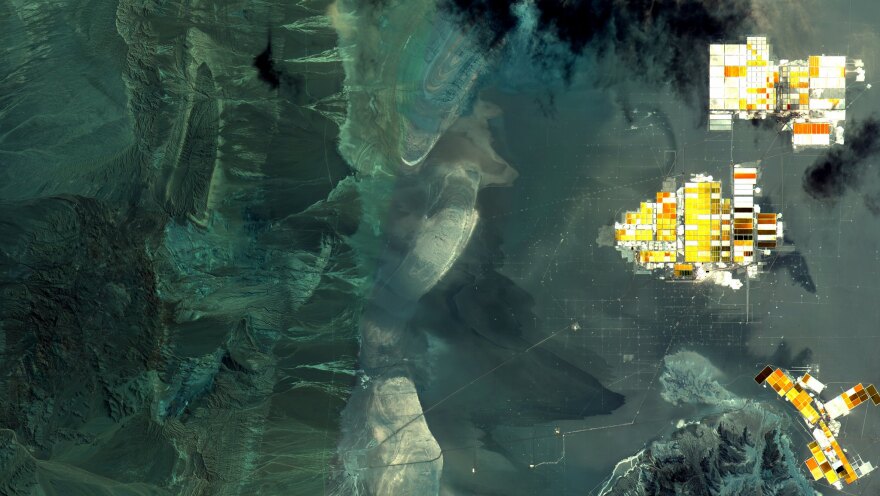This week, during their highly anticipated “Battery Day” event, Tesla CEO Elon Musk laid out the company’s plan to have a $25,000 electric vehicle on the market within three years. He also mentioned that the company will be breaking into the lithium mining business.
Experts are skeptical. But why?
This story is part of the Covering Climate Now's Climate Politics 2020 joint coverage week.
The Lithium Gold Rush
Taylor Quimby
Transitioning to an all-electric vehicle fleet absolutely depends on lithium, the most important ingredient in the lithium-ion battery.
But there is no “Lithium Central Planning Committee” balancing supply and demand, or making sure that lithium is mined in environmentally and socially responsible ways: and there are projected shortages of battery grade lithium in the coming years.
American Lithium
From the 1950s until the 1980s, nearly all of the world’s lithium was extracted from a pair of mines in North Carolina. But demand has grown. The first commercial product featuring a lithium-ion battery was the Sony Handycam Camcorder. Since then, lithium-fueled products have proliferated across world - digital cameras, laptops, cellphones, and more. Meanwhile, lithium mining in America has become virtually non-existent.
In Nevada, home of a joint lithium ion-battery plant run by Tesla and Panasonic, there is an effort underway to change that. A proposed mine that would extract and produce lithium chemicals and boric acid. However, the proposed mine footprint overlaps with the only known habitat of a rare wildflower called Tiehm’s Buckwheat.
Patrick Donnelly is Nevada State Director of the Center for Biological Diversity. He says he recognizes the need to transition to electric vehicles.
“Biodiversity is what gives us clean drinking water and clean air to breathe and puts food on our table. And so if we let species go extinct because of our own desires, we are threatening our own way of life on Earth. I hear you - we need lithium. There are many, many, many places to get lithium that don’t have an endemic species of flower directly above them.”

Scientists at the University of Nevada, Reno are working to cultivate and transplant populations of Tiehm's buckwheat. Through right-to-know requests, Donnelly and the Center for Biological Diversity has obtained documents that reveal how the mining company, Ioneer ltd, is trying to pressure them to release findings before they are ready to be published. Donnelly says Ioneer is trying to prevent the buckwheat from being listed under the endangered species act, which could delay and possibly end the project altogether. Furthermore, in recent weeks many of the flowers have been removed and likely destroyed. Representatives from the mine (and some scientists) have suggested the buckwheat was eaten by rodents – others have suggested the destruction was intentional sabotage.
Lithium Trade-offs
Australia is the largest single producer of lithium, but 60% of the world’s lithium reserves can be found underneath the massive salares (or salt flats) of South America, where activists, scientists, and indigenous communities have warned that extraction of lithium (and other minerals) threatens not just a single species – but entire ecosystems and economies.
Ramon Morales Balcazar is a founding member of the Plurinational Observatory of the Andean Salt Flats.
“Between 20 and 25 percent of all the lithium in the world comes from the Atacama salt flats. That cannot be sustainable.”

Mining for materials related to our renewable transition forces environmental activists and policymakers to confront trade-offs that traditionally were problems easily blamed on the opposition.
Climate policies like the Paris Agreement and The Green New Deal have pushed for a dramatic increase in renewable technology, but don’t tackle how and where to acquire the minerals those increases will require.
This isn’t a problem that the environmental movement is ignoring, but conservatives have leapt on this reality in order to claim that the cure for climate change is worse than the problem.
Julian Brave NoiseCat is Vice President of policy and strategy for the left-wing think tank Data for Progress. He says, a lot of environmental justice advocates were driven to action because of oil, gas and mineral projects that exploit native communities, poor communities, and communities of color. So understandably, the push for renewables is part of desire to emancipate society from that paradigm.
But activists also recognize action on climate change is needed urgently.
“And you know this is something that I wish was not true, but the reality of politics and policy is encountering truths that you wish were not there but are in fact there, that there may in some instances be a trade-off between just and equitable outcomes, and the imperative to move very quickly. I think that’s largely a function of the fact that we’ve waited so long.”
This story features Emily Hersh, Chloe Holzinger, Patrick Donnelly, Thea Riofrancos, Ramón M. Balcázar, and Julian Brave NoiseCat.








